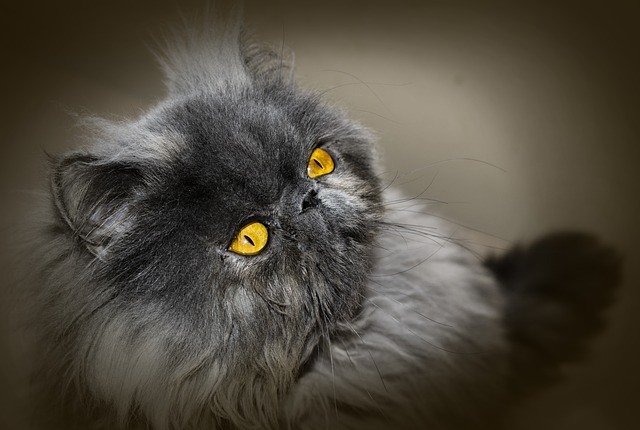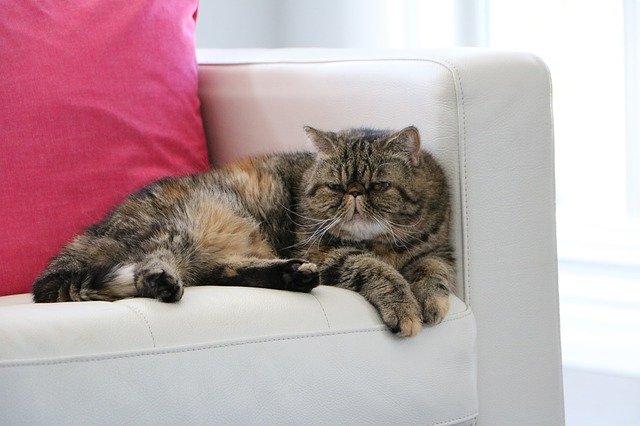
Persian cats are one of the world’s most popular cat breeds. But did you know there are many different variations that can be classified in this breed?
You may be familiar with Himalayan Persians, but did you know there are also Doll Faced, Bicolor and Chinchilla Persian cats?
Don’t worry, we are going to walk through this together. Once you finish reading this guide you will have a better understanding of the different types of Persian cats.
Persian Cat Varieties
Honestly, it would be impossible to discuss every type of Persian cat. Since there are so many breeders, there are countless varieties of this breed.
In this post, we are just going to focus on the major varieties of Persian cats. Ready? Let’s dive in!
Doll Face Persian

Doll Face Persian cats are also known as Traditional or Old Fashioned Persians. This variant is believed to be the original Persian cat. Today, these cats still look virtually the same as the oldest available images of Persian cats.
This type of Persian does not exhibit extreme features. Its nose is a normal length, which is proportional to the rest of its face. Unlike Peke-Faced Persians, these cats have a nose that extends outward. So, Doll Face Persian cats can breathe easier than some other Persian cats. They also experience less eye staining and eye drainage issues.
These cats usually don’t experience the health problems this breed is known for. They don’t have the squished facial features. But, they are the classic version of this breed and are still very recognizable as Persian cats.
Doll Face Persians have long flowing coats. They come in a variety of colors. So, even though they don’t experience many health problems, they are still a high-maintenance breed. They require a regular grooming schedule. But, if you want to avoid breathing challenges or tear-draining issues, this is a safe variant to consider.
Peke-Face Persian

Show Persian cats, or Peke-Face Persians, have the more recognizable Persian cat features. This breed’s name comes from their similarities to Pekingese dogs. A genetic mutation causes the flat face in this Persian variation.
These cats have a square-shaped head, a small nose, and a long jaw. They also have round cheeks and large circular eyes. This facial structure causes Peke-Face Persian cats to have difficulty breathing. If a Show Persian cat has a cold, it becomes almost impossible for these cats to breathe normally. Many of these Persians experience asthma. Often, their noses appear to be set directly between their eyes.
Peke-Face Persians are a high-maintenance breed. In addition to regularly grooming their long coats, owners have to frequently wipe these cat’s eyes. Their eyes have drainage issues, which can cause fur staining if not properly managed.
Chinchilla Persian

Chinchilla Persian cats are a very striking variation. These cats have thick, bushy coats. They were originally named after the South American rodent that also possesses a thick, white coat.
While there are a few different color-variations, Chinchilla Persian cats are typically silvery white. Their doll-like eyes, lips, and nose are rimmed in black. These cats have a light undercoat and a subtly-tinted overcoat. They also either have green or blue eyes.
Since Chinchilla Persian cats are purebred, they typically exhibit health problems. They are prone to kidney disease and heart problems. Also, they sometimes have flat-faces, which could cause breathing issues.
Exotic Shorthair

The Exotic Shorthair was bred to be the shorthair variant of a Persian cat. This variation exhibits most typical Persian characteristics. They have a flat face and large eyes. Unlike the longhair variations, these cats are capable of grooming themselves.
Unfortunately, their facial structure causes the standard health problems related to Persian cats. They often have difficulty breathing and can exhibit tear duct drainage issues. Also, these cats are more playful than traditional longhair Persians. They are very affectionate and don’t like being left alone.
Teacup Persian

Teacup Persians are bred to be tiny. Breeders aim to produce the smallest Persian cats possible. And while these are adorable, you should think twice before adopting a Teacup Persian.
Full-sized Persian cats already experience a variety of health problems. And since these cats are bred to be small, their chances of experiencing health problems only increase. Persian cats already have small-squished faces. And smaller faces just make it even hard for Teacup Persian cats to breathe.
These cats also have challenges regulating their body temperature and dealing with stress. Also, since these are a highly bred variation, they usually come with a high price tag.
The Cat Fancier’s Association Persian Cat Divisions
In addition to these variations, The Cat Fancier’s Association has 7 color divisions of Persian cats. These are the classifications recognized for cat show purposes.
Solid
Persian cats in the solid division have a single-colored coat. Their coat does not contain any patterns or markings. They can be white, black, silver, blue, or chocolate.
Silver & Golden
This variety exhibits a coat marking called “tipping.” A tipped coat is characterized by white coloring throughout with a subtle darker color on the tip of extremities, like the ears and paws. Silver & Golden Persians have a light “tipping” on their backs, face, or legs. This tipping is subtle and is uniform throughout their fur.
Chinchilla Persians fall under this color division.
Smoke & Shaded
Shaded Persians have a white undercoat and a subtly colored overcoat. The overcoat can have golden or red hues.
Smoke Persians have a darker overcoat. Their overcoat can be black, brown, or blue. In some cases, the dark color appears to be the entire color of the coat. But when these cats walk, you can glimpse their white undercoat.
Tabby
Tabby Persians are further categorized into classic, mackerel and patched varieties. These cats have striking fur markings. They almost resemble markings normally attributed to wild cats.
Tabby Persians are also known for their outgoing personalities. These cats are more playful and active than other Persian varieties.
Particolor
These Persians are often referred to as tortoiseshell Persians. Their coats consist of multiple colors. And, their coloring is usually darker than Tabby Persians.
Also, instead of the stripes seen in Tabby Persians, these cats have splotchy fur markings.
Bicolor
Instead of the multiple colors seen in Particolor Persians, the Bicolor variant only has two color patterns. These can be white, brown, red, blue, or black.
Calico Persians fall under this color division.
Himilayan
Ok, you’ve probably been waiting for this one. The Himalayan is the most recognizable Persian cat variety.
The Himalayan variety was first developed when a breeder crossed a Persian and Siamese. These cats are known for having Siamese coloring and Persian features. All Himalayan cats have piercing blue eyes.
Himalayan Persians can have a flat or round face. Flat-faced Himilayans, unfortunately, experience the health problems seen in other Persian cat varieties.
Himalayan Persians are generally calm. But, they sometimes exhibit a playful nature attributed to their Siamese heritage.
Recap
Ok, that was a lot of information. But, we hope this post gave you a better understanding of the different types of Persian cats. Let’s do a quick recap to make sure we are all on the same page.
There is only one breed of Persian cats. But over the years, breeders have developed many different varieties of this breed.
Some of the distinctions between the varieties are seen in the Persian’s facial structures. The original Persian cats have round faces. They don’t experience the breathing difficulties that other variations suffer from. Peke-faced Persians have a flat face, which causes a variety of health problems. This variation especially suffers from breathing problems.
In additional to facial structures, their coats are used to differentiate Persian cat varieties. Chinchilla Persians have long, white furry coats. The Exotic Shorthair is the only variety of short-haired Persians. All other variations have the long coats that we typically associate with Persian cats.
Persian cats are also classified by size. While most Persians are a standard size, breeders have developed the tiny Teacup variety. These cats are very small. Their unusually small size causes them to experience a variety of health problems.
Finally, Persian cats are also classified by their coat color. The Cat Fancier’s Association has determined the 7 different Persian cat color variations. These are mostly determined by their coat patterns and color markings.
Final Thoughts
Alright, do you now have a better understanding of Persian cat variations? We hope so! Just remember, there is only one Persian cat breed. But there are different varieties based on coloring, fur length, size, and facial structure.
If you are planning to adopt, make sure you research the breeder before deciding on a cat. But if you adopt from a reputable breeder, it is ultimately up to you to decide which type of Persian cat to adopt.
What type of Persian cat do you own? Did you learn about a new variety in our post? We would love to hear from you in the comments!
I want this cat quickly before traveling
They are so cute
I’m adopting a Persian next week – my first pedigree cat so I’m getting nervous! But excited!
Hi Sian, congrats on adopting a Persian, they really are a great breed, you do need to take care of their coat a bit more than some breeds but once you get used to this it isn’t bad at all. If you have any questions regarding your new Persian, be sure to drop us a message.
Best of luck.
Shaun
Please tell me where and how I can get a Traditional Persian cat. Can’t wait to give love and home for our new member.
I’d start by looking at your local rescue centres and registering with them.
Mine has lots respiratory issues. Next cat I’m going back to a Birman cat.
can you please help me, what breed of persian is my cat? im finding it hard to know, thank you so much
Could you email a picture over and I may be able to help you.
We adopted a traditional blue cream Persian who wandered into our yard. She was desexed but not microchipped and as no one claimed her, we did. She fits in well with our other rescue cat and we keep telling her – you knew which house to pick!
We adopted two doll faced Prussian cats silver and orange gold one and half month kitties and named them Silvie and Goldie Silvie is female Goldie is male both are extremely adorable and cute and loving and affectionate…
so CUTE!!!!!!!!!!!!!!!!!!!!!!!!!!!!!!!!!!!!!!!!!!!!!!!!!!!!!!!!!!!!!!!!!! 🙂
We will be having our first indoor doll face Persian cat next month and we are so excited making preparations for his arrival! We have a separate small kitchen separated from our main house with a door and we will place him there. We are planning on giving him a companion-our adapted 6-month old stray kitten . My problem now is about purchasing his feeding bowl..and I don’t know what to buy
Anything that’s shallow works well for a Persian. I have a blog post on the subject here that you might find useful http://persiancatcorner.com/best-food-bowls-for-persian-cats/
Can a Persian be both doll-faced and chinchilla? My cat seems to have features of both.
So I’m adopting one in about two months, and I couldn’t find any Persian Cat on the internet similar to how the owners of their parents tell me that their fur’s going to look like, the cat it’s white, but the owners tell me they’re going to have a golden kind of shade over the tail, tip of the ears, and paws too. ¿What’s that kind of fur color called?